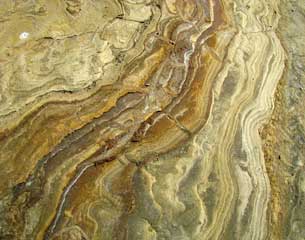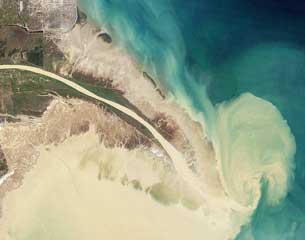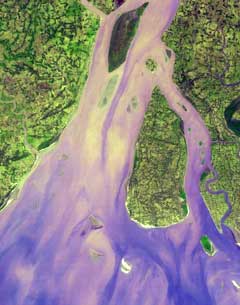Learn important facts about erosion to help understand how erosion affects the land and how erosion affects water. Erosion is the largest cause of loss of topsoil. It is also the leading cause of sediment deposits in ditches, streams, rivers, lakes and oceans. Soil erosion also causes water quality issues. As the sediment is transported downstream, much of the sediment from erosion is suspended in the water making it look dirty instead of clear. Learn more about erosion with these erosion facts.

Where does soil erosion occur?
- Anywhere that fast moving water moves across soil, erosion can occur. If the water is moving fast enough, water can pick up and move rocks.
- Erosion occurs more frequently where the ground is sloped with a steep grade, not on flat ground. The velocity of water increases as it moves down hill.
- Places where there are no roots from vegetation holding the soil in place require less water speed to cause erosion.
- Erosion occurs more frequently within soils with a small particle size. Silts have the smallest particle size, followed by clay. Silt and clay are most often found when suspended erosion soils are studied in water.
- Scientists estimate the Amazon River contributes 20 percent of the overall soil erosion that enters oceans around the world. It is estimated that the Amazon River transports over a billion tons of sediment to the Atlantic Ocean each year. A majority of the soils suspended in the Amazon River sediment appear to be from the Andes Mountains, located at the source of the river.
- Lakes are not immune from problems with deposits of soil erosion sediments. For example, according to the U.S. Army Corps of Engineers, the Maumee River in Ohio deposits over 1.4 million tons of sediment each year into Lake Erie (one of the Great Lakes). The Port of Toledo was once one of the major shipping ports on the Great Lakes. Today sediments from soil erosion must be dredged to continue to keep shipping lanes open.
- Beach erosion occurs throughout the world. Waves crashing on the beaches cause sand to wash out into the ocean. Storms such as hurricanes and typhoons are responsible for a majority of beach erosion.
Soil Erosion Laws in the United States
Most laws regulate soil erosion by controlling water quality. These laws in the United States and most of the world try to keep water clean by limiting the amount of soil erosion sediment that enters the water. These laws also help keep topsoil in place to grow plants
- 1972 The United States Federal Government established the Federal Water Pollution Control Act (FWPCA). This act set up laws to control water pollution.
- 1977 An amendment to the Federal Water Pollution Control Act was made to create the Clean Water Act (CWA). This act set water quality standards.
- 1978 An amendment to the Clean Water Act called The National Pollutant Discharge Elimination System (NPDES). This amendment requires a permit to discharge stormwater directly to waters of the United States. Stormwater is any water that flows off a property during or after a rain storm.
- Each individual state then set guidelines, including erosion control in stormwater requirements. Construction projects are also required to follow these guidelines in most states.
Ways to Limit the Amount of Soil Erosion
Here are some ways to reduce or eliminate stormwater soil erosion. Farmers, engineers and developers use the following items to help limit the amount of stormwater soil erosion runoff.
- Place rock ditch checks (mini-dams in the ditch made out of rock to slow the water down)
- Filter fabric ditch checks (the same as above, except the dam is made from a fabric)
- Inlet protection (placing filter fabric fences around stormwater drains)
- Erosion control mats (permanent or temporary mats placed over the ground to stop exposure of the soil with fast-moving water)
- Perimeter filter fabric fences (placing filter fabric around an entire construction project to improve water quality runoff)
- Construction seed and mulch (plant seed and place mulch to promote fast-growing grasses and weeds to slow down surface erosion)
- Trees and plants (plant trees or plants to establish root structures to contain the soil and slow down water flow)

The Yellow River in China flows into the Ngoring Lake. The soil erosion sediment is clearly seen in this photo. Photo credit: nasa.gov

Soil erosion sediment from the Ganges River clouds the outlet water. Photo credit: nasa.gov
